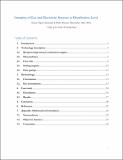| dc.description.abstract | Distributed energy resources for space conditioning comprise a set of varied technologies, ranging from mature well established systems such as furnaces, boilers, and air-conditioning (AC) units to emerging ones such as micro combined heat and power (micro-CHPs), reversible heat pumps, and hybrid gas-electricity conditioning systems. Micro-CHP systems, for instance, will have different prime movers depending on the underlying conversion process. Therefore, reciprocating engines, microturbines, and fuel cells-based CHPs have different technological characteristics and dissimilar market maturity levels, which make them attractive for a variety of applications at various scales. Depending on the quality of the thermal energy contained in the exhaust gas and cooling systems, this can be used to produce hot water, low- to medium-pressure steam, and heating and cooling for space conditioning.
This paper looks into the relative value of using gas- and electricity-based systems for space conditioning for residential consumers. The profitability of these technologies is the key metric for comparison, as it is what consumers mostly consider when deciding to adopt one technology over another. Performance characteristics such as efficiency and heat-to-power ratio, as well as economic characteristics such as capital and operational costs, energy prices and their associated tariff structure are expected to have a major impact not only in their profitability, but also on how they compete each other to meet the consumers’ energy needs. Motivated by this, the specific question we explore in this case study is: “What would the costs and benefits be of gas and electricity DERs used for space conditioning under different market and climatic conditions?”
The structure of the paper is a follows. In the first half of this document, we concisely describe the salient features of these gas- and electricity-based systems for space conditioning. In the second half of this paper, we assess the relative value of using gas- and electricity-based systems for space conditioning for residential consumers, looking at the primary energy, their profitability and annual energy costs savings under several scenarios. | en_US |
